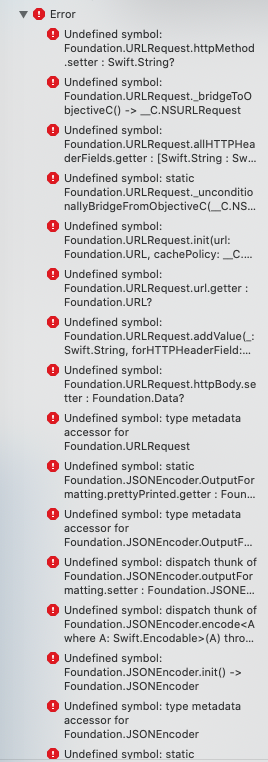React-Native bridge for Crisp chat iOS and Android SDK's
- iOS & Android Support (In beta)
- Typescript Support
- Expo support with custom dev client
Install the library using either yarn or npm like so:
yarn add react-native-crisp-chat-sdknpm install --save react-native-crisp-chat-sdkThis package is not available in the Expo Go app. Learn how you can use it with custom dev clients.
If you're using React Native versions > 60.0, it's relatively straightforward.
cd ios && pod installFor versions below 0.60.0, use rnpm links
- Run
react-native link react-native-crisp-chat-sdk - If linking fails, follow the manual linking steps
Start using Crisp by adding the following code on your AppDelegate.m :
#import <Crisp/Crisp.h>
[CrispSDK configureWithWebsiteID:@"YOUR_WEBSITE_ID"];Start using Crisp by adding the following code on your AppDelegate.mm :
#import <Crisp/Crisp-Swift.h>
[CrispSDK configureWithWebsiteID:@"YOUR_WEBSITE_ID"];To enable your users to take and upload photos to the chat as well as download photos to their photo library, add the
Privacy - Camera Usage Description (NSCameraUsageDescription) and Privacy - Photo Library Additions Usage Description (NSPhotoLibraryAddUsageDescription) to your app's Info.plist.
This library was written in Swift, so in-order for you app to compile, you need to have at least one .swift file in your source code a bridging header to avoid a runtime error like so:
All you have to do is:
- File > New > File
- Swift File
- Name the file whatever you wish
- When prompted to create a bridging header, do so
Add our bintray in your repositories.
RN 0.65.0 has removed jscenter() but its important that we add it back in for now. Once the offical Crisp Android SDK removes this dependency we can revert back.
repositories {
// Keep your previous repositories
mavenCentral()
}Add the Crisp SDK in your dependencies in app/build.gradle:
implementation 'im.crisp:crisp-sdk:1.0.14'Configure your app for multidex:
android {
defaultConfig {
multiDexEnabled true
}
}
dependencies {
// If you're using AndroidX
implementation 'androidx.multidex:multidex:2.0.1'
// If you're not using AndroidX
implementation 'com.android.support:multidex:1.0.3'
}Initialize the library in your Application subclass
import im.crisp.client.Crisp;
// Fixes multiDex error
import androidx.multidex.MultiDexApplication;
public class MainApplication extends MultiDexApplication implements ReactApplication {
@Override
public void onCreate() {
super.onCreate();
// Replace it with your WEBSITE_ID
// Retrieve it using https://app.crisp.chat/website/[YOUR_WEBSITE_ID]/
Crisp.configure(getApplicationContext(),"YOUR_WEBSITE_ID");
}
}NSCameraUsageDescription and NSPhotoLibraryUsageDescription in Info.plist, to inform your users that you need to access to the Camera and Photo Library. You also have to enable "iCloud Documents" capability
Your website ID can be found in the Crisp App URL:
Crisp Website ID is an UUID like e30a04ee-f81c-4935-b8d8-5fa55831b1c0
You can view the example project for more usage.
import CrispChat, {
setUserEmail,
setUserNickname,
setUserPhone,
resetSession,
} from 'react-native-crisp-chat-sdk';
// ...
export default function App() {
// this should be user ID that way app will load previous user chats
setUserTokenId('abcd12345');
// Set user's info
setUserEmail('test@test.com');
setUserNickname('John Smith');
setUserPhone('+614430231224');
// Call session reset when user loggs out
resetSession();
return <CrispChat />;
}Explicitly setting alternative languages from React is not currently supported. Nevertheless, the underlying SDK is able to select automatically the locale matching the one of device. The locale detection works out-of-the-box on Android. However, for the locale of the device to be detected on iOS apps, it has to be declared and setup in xcode as a supported language.
Here is a suggested method for adding languages support to your app in Xcode 13:
Start by adding support for your particular language in your project info (<yourProject> > Info > Localizations >
+). To make it active, you also need to create at least one dummy StringFile (File > New > File...) with a
localized version matching the language you wish to add support to. After this step, if the locale of the device matches
the language you set up, it will be exposed by the app and chosen by the Crisp SDK. Note that alternative methods may
exist, but have not been tested regarding the locale detection of the Crisp SDK.
For iOS apps, debugging the preferred language exposed by your app can be achieved by adding the following line in your
AppDelegate.m file : NSLog(@"localeIdentifier: %@", [[NSLocale currentLocale] localeIdentifier]);
If for example, localeIdentifier: en_FR or localeIdentifier: en_US appears in your Xcode logs, then Crisp will be
displayed in english. If localeIdentifier: fr_FR appears in your Xcode logs, it will be displayed in french.
CrispChatSDK.show()CrispChatSDK.setTokenId('userID/GUID')CrispChatSDK.pushSessionEvent(name: "Signup", color: CrispSessionEventColors.blue)CrispChatSDK.setUserEmail('test@test.com')CrispChatSDK.setUserNickname('John Doe')CrispChatSDK.setUserPhone('003370123456789')CrispChatSDK.setUserAvatar('https://pbs.twimg.com/profile_images/782474226020200448/zDo-gAo0_400x400.jpg')CrispChatSDK.setSessionSegment('segment')CrispChatSDK.setSessionString('key', 'value')CrispChatSDK.setSessionBool('key', 'value')CrispChatSDK.setSessionInt('key', 'value')CrispChatSDK.resetSession()
See the contributing guide to learn how to contribute to the repository and the development workflow.
MIT

